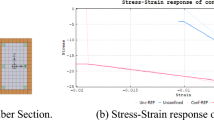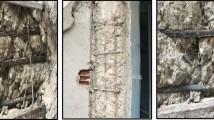Abstract
Stiffness is an important parameter for the seismic design of shear walls, which is related to the shear force distribution of each wall member. The stiffness degradation occurs in shear walls under the effect of earthquakes, and the effect of stiffness degradation is considered by a constant reduction factor in many design codes. However, the constant reduction factor cannot consider the whole stiffness degradation process of shear walls. The aim of this paper is to experimentally study and model the stiffness degradation of shear walls under cyclic loading. Five wall specimens were tested under cyclic loading to study the influence of reinforcing bar strength, axial load ratio, failure mode, and cross-section type on the stiffness degradation. Based on the experimental stiffness degradation curves of rectangular shear walls failing in flexure, a four-line stiffness degradation model controlled by crack, yield, peak, and ultimate points was proposed, and the calculation methods for the values of each point were established. The four-line stiffness degradation model was used to obtain the analytical stiffness degradation curves of the wall specimens, which were compared with the experimental stiffness degradation curves. Study shows that increasing reinforcing bar strength decreases the initial stiffness, and increasing axial load ratio significantly improve the initial stiffness while accelerating the stiffness degradation rate with drift ratio. The stiffness of shear walls failing in flexure is more fully degenerated than that of shear walls failing in shear. The stiffness of T-shaped shear walls is larger loaded in the positive direction than that loaded in negative direction. The flange improves the stiffness while accelerates the stiffness degradation rate with drift ratio. The analytical and experimental stiffness degradation curves were in the reasonable agreement.















Similar content being viewed by others
References
ACI 318-14 (2014) Building code requirements for structural concrete and commentary (ACI 318-14). American Concrete Institute, Farmington Hills
ASCE-41 (2006) Seismic rehabilitation of buildings. American Society of Civil Engineers, ASCE, Reston
ATC-72 (2010) Modeling and acceptance criteria for seismic design and analysis of tall buildings. Applied Technology Council, California
Carrillo J (2014) Damage index based on stiffness degradation of low-rise RC walls. J Earthq Eng Struct Dyn 44(6):831–848
Carrillo J, Vargas D, Sánchez ML (2018) Stiffness degradation model of thin and lightly reinforced concrete walls for housing. Eng Struct 168:179–190
Fang X, Zhaolin LI, Hong W, Yi J (2011) Experimental study on seismic behavior of high performance concrete shear wall with high reinforcement ratio boundary elements. J Build Struct 32(12):145–153
Fenwick R, Bull D (2000) What is the stiffness of reinforced concrete walls. SESOC J. 13(2):9–13
GB 50010-2016 (2016) Code for design of concrete structures. China Architecture & Building Press, Beijing (in Chinese)
GB/T 228.1-2010 (2011) Metallic materials-tensile testing-part 1: method of test at room temperature. Standards Press of China, Beijing (in Chinese)
GB/T 50081-2002 (2003) Standard for test method of mechanical properties on ordinary concrete. China Architecture & Building Press, Beijing
Guo Z, Shi X (2003) Reinforced concrete theory and analyses. Tsinghua University Press, Beijing, pp 183–188 (in Chinese)
Guo R, Zhu K (2017) Experimental research on seismic behavior of RC shear wall with hrb600 high-strength reinforced bars. Ind Build 47(06):34–39
Hawkins NM, Ghosh SK (2004) Acceptance criteria for special precast concrete structural walls based on validation testing. PCI J 49(5):s78–s92
JGJ3-2010 (2010) Technical specification for concrete structures of tall building. China Construction Press, Beijing (in Chinese)
Li B, Xiang W (2011) Effective stiffness of squat structural walls. J Struct Eng 137(12):1470–1479
Li Z, Song Y, Zhang H, Xie Y, Ma H (2014) Study of seismic performance of RC shear wall with 1000 MPa high-strength bars. Ind Build 44(12):57–62 (in Chinese)
Liang X, Deng M, Zhang X, Tian S (2007) Experimental study on performance-based seismic design of high performance concrete shear wall. J Build Struct 28(5):80–88
Lu YQ, Huang L (2014) Experimental data-based calculation method for ultimate displacement of flexure dominated RC walls with concealed columns. J Build Struct 35(2):80–88
NZS 3101:2006 (2006) Concrete structures standard. Standards New Zealand, Wellington
Oh YH, Han SW, Lee LH (2010) Effect of boundary element details on the seismic deformation capacity of structural walls. Earthq Eng Struct Dyn 31(8):1583–1602
Park R (1989) Evaluation of ductility of structures and structural assemblages from laboratory testing. Bull N Z Natl Soc Earthq Eng 22(3):155–166
Paulay T, Priestley MJN (1993) Stability of ductile structural walls. ACI Struct J 90(4):385–392
Su RKL, Wong SM (2007) Seismic behaviour of slender reinforced concrete shear walls under high axial load ratio. Eng Struct 29(8):1957–1965
Thomsen IJH, Wallace JW (2004) Displacement-based design of slender reinforced concrete structural walls-experimental verification. J Struct Eng 130(4):618–630
Wei H, Gong Z, Fang X, Chen Z (2010) Experimental research on seismic performance of short-pier shear wall structure with rectangular section. Build Struct 40(03):71–74
Xiaolei H, Binbin C, Jidong C, Zhouchi P, Jing JI, Dianlong S (2018) Experimental study on deformation performance indexes of RC shear walls. J Build Struct 39(6):1–9
Zhang Z, Li B (2018) Effective stiffness of non-rectangular reinforced concrete structural walls. J Earthq Eng 22(3):382–403
Zhang S, Lü X, Zhang H (2009) Experimental and analytical studies on the ultimate displacement of RC shear walls. China Civ Eng J 42(4):10–16 (in Chinese)
Zheng S, Hou P, Li L, Wang B, Yu F, Zhang H (2012) Experimental study of the damage of RC shear walls under low cycle reversed loading. China Civ Eng J 45(2):51–59 (in Chinese)
Zhou Y, Liu Z, Liu F, Wu C (2008) Experimental study on seismic performance of the short-pier shear wall (SPW) with rectangular section. J Build Struct 29(4):81–88
Acknowledgements
Funding was provided by the Major State Basic Research Development Program of China (Grant No. 2012CB026200), Natural Science Foundation of Jiangsu Province (Grant No. BK20171361) and Graduate Research and Innovation Projects of Jiangsu Province (Grant No. KYCX18_0108).
Author information
Authors and Affiliations
Corresponding author
Additional information
Publisher's Note
Springer Nature remains neutral with regard to jurisdictional claims in published maps and institutional affiliations.
Rights and permissions
About this article
Cite this article
Ni, X., Cao, S., Li, Y. et al. Stiffness degradation of shear walls under cyclic loading: experimental study and modelling. Bull Earthquake Eng 17, 5183–5216 (2019). https://doi.org/10.1007/s10518-019-00682-5
Received:
Accepted:
Published:
Issue Date:
DOI: https://doi.org/10.1007/s10518-019-00682-5




